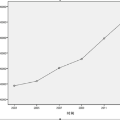Hierarchical forecasting problems arise when time series have a natural group structure, and predictions at multiple levels of aggregation and disaggregation across the groups are needed. In such problems, it is often desired to satisfy the aggregation constraints in a given hierarchy, referred to as hierarchical coherence in the literature. Maintaining coherence while producing accurate forecasts can be a challenging problem, especially in the case of probabilistic forecasting. We present a novel method capable of accurate and coherent probabilistic forecasts for time series when reliable hierarchical information is present. We call it Deep Poisson Mixture Network (DPMN). It relies on the combination of neural networks and a statistical model for the joint distribution of the hierarchical multivariate time series structure. By construction, the model guarantees hierarchical coherence and provides simple rules for aggregation and disaggregation of the predictive distributions. We perform an extensive empirical evaluation comparing the DPMN to other state-of-the-art methods which produce hierarchically coherent probabilistic forecasts on multiple public datasets. Comparing to existing coherent probabilistic models, we obtain a relative improvement in the overall Continuous Ranked Probability Score (CRPS) of 11.8% on Australian domestic tourism data, and 8.1% on the Favorita grocery sales dataset, where time series are grouped with geographical hierarchies or travel intent hierarchies. For San Francisco Bay Area highway traffic, where the series' hierarchical structure is randomly assigned, and their correlations are less informative, our method does not show significant performance differences over statistical baselines.
翻译:分层预测问题在时间序列具有自然的分组结构时会出现,需要在不同层次和分组中进行预测。在这类问题中,通常希望满足给定层次结构上的聚合约束,称为分层一致性。在产生准确预测的同时保持一致性可能是一个具有挑战性的问题,尤其是在概率预测的情况下。我们提出了一种新颖的方法,能够在存在可靠分层信息的时间序列中产生准确且一致的概率预测。我们称之为深度泊松混合网络(DPMN)。它依赖于神经网络和分层多元时间序列结构的联合分布的统计模型的组合。通过构建,该模型保证分层一致性,并提供了预测分布的聚合和拆分的简单规则。我们进行了广泛的实证评估,比较了DPMN与其他在多个公共数据集上产生分层一致性概率预测的最先进方法。与现有的一致概率模型相比,我们在澳大利亚国内旅游数据上获得了总体连续排名概率分数(CRPS)相对改进了11.8%,在Favorita杂货销售数据集上相对改进了8.1%,其中时间序列与地理层次或旅行意图层次进行分组。对于旧金山湾区公路交通数据,在该数据集中时间序列的分层结构随机分配,它们的相关性不那么显著,我们的方法在统计基准线上并没有显示出显著的性能差异。


